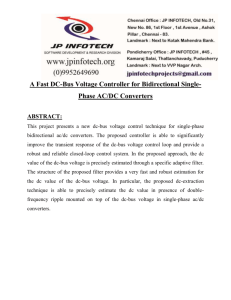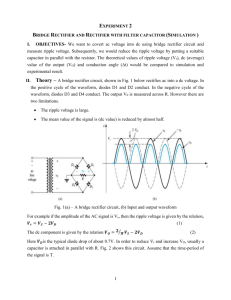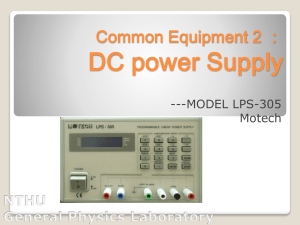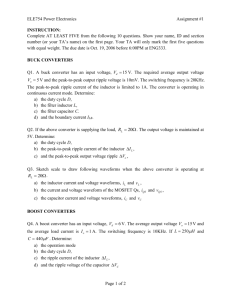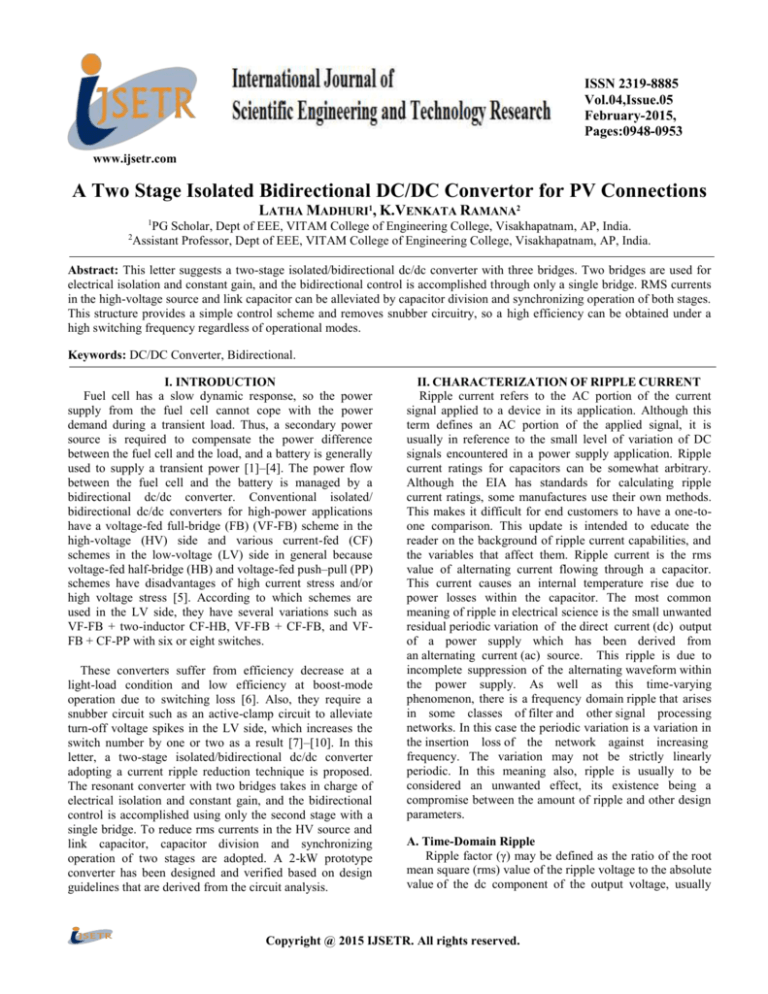
ISSN 2319-8885
Vol.04,Issue.05
February-2015,
Pages:0948-0953
www.ijsetr.com
A Two Stage Isolated Bidirectional DC/DC Convertor for PV Connections
LATHA MADHURI1, K.VENKATA RAMANA2
PG Scholar, Dept of EEE, VITAM College of Engineering College, Visakhapatnam, AP, India.
2
Assistant Professor, Dept of EEE, VITAM College of Engineering College, Visakhapatnam, AP, India.
1
Abstract: This letter suggests a two-stage isolated/bidirectional dc/dc converter with three bridges. Two bridges are used for
electrical isolation and constant gain, and the bidirectional control is accomplished through only a single bridge. RMS currents
in the high-voltage source and link capacitor can be alleviated by capacitor division and synchronizing operation of both stages.
This structure provides a simple control scheme and removes snubber circuitry, so a high efficiency can be obtained under a
high switching frequency regardless of operational modes.
Keywords: DC/DC Converter, Bidirectional.
I. INTRODUCTION
Fuel cell has a slow dynamic response, so the power
supply from the fuel cell cannot cope with the power
demand during a transient load. Thus, a secondary power
source is required to compensate the power difference
between the fuel cell and the load, and a battery is generally
used to supply a transient power [1]–[4]. The power flow
between the fuel cell and the battery is managed by a
bidirectional dc/dc converter. Conventional isolated/
bidirectional dc/dc converters for high-power applications
have a voltage-fed full-bridge (FB) (VF-FB) scheme in the
high-voltage (HV) side and various current-fed (CF)
schemes in the low-voltage (LV) side in general because
voltage-fed half-bridge (HB) and voltage-fed push–pull (PP)
schemes have disadvantages of high current stress and/or
high voltage stress [5]. According to which schemes are
used in the LV side, they have several variations such as
VF-FB + two-inductor CF-HB, VF-FB + CF-FB, and VFFB + CF-PP with six or eight switches.
These converters suffer from efficiency decrease at a
light-load condition and low efficiency at boost-mode
operation due to switching loss [6]. Also, they require a
snubber circuit such as an active-clamp circuit to alleviate
turn-off voltage spikes in the LV side, which increases the
switch number by one or two as a result [7]–[10]. In this
letter, a two-stage isolated/bidirectional dc/dc converter
adopting a current ripple reduction technique is proposed.
The resonant converter with two bridges takes in charge of
electrical isolation and constant gain, and the bidirectional
control is accomplished using only the second stage with a
single bridge. To reduce rms currents in the HV source and
link capacitor, capacitor division and synchronizing
operation of two stages are adopted. A 2-kW prototype
converter has been designed and verified based on design
guidelines that are derived from the circuit analysis.
II. CHARACTERIZATION OF RIPPLE CURRENT
Ripple current refers to the AC portion of the current
signal applied to a device in its application. Although this
term defines an AC portion of the applied signal, it is
usually in reference to the small level of variation of DC
signals encountered in a power supply application. Ripple
current ratings for capacitors can be somewhat arbitrary.
Although the EIA has standards for calculating ripple
current ratings, some manufactures use their own methods.
This makes it difficult for end customers to have a one-toone comparison. This update is intended to educate the
reader on the background of ripple current capabilities, and
the variables that affect them. Ripple current is the rms
value of alternating current flowing through a capacitor.
This current causes an internal temperature rise due to
power losses within the capacitor. The most common
meaning of ripple in electrical science is the small unwanted
residual periodic variation of the direct current (dc) output
of a power supply which has been derived from
an alternating current (ac) source. This ripple is due to
incomplete suppression of the alternating waveform within
the power supply. As well as this time-varying
phenomenon, there is a frequency domain ripple that arises
in some classes of filter and other signal processing
networks. In this case the periodic variation is a variation in
the insertion loss of the network against increasing
frequency. The variation may not be strictly linearly
periodic. In this meaning also, ripple is usually to be
considered an unwanted effect, its existence being a
compromise between the amount of ripple and other design
parameters.
A. Time-Domain Ripple
Ripple factor (γ) may be defined as the ratio of the root
mean square (rms) value of the ripple voltage to the absolute
value of the dc component of the output voltage, usually
Copyright @ 2015 IJSETR. All rights reserved.
LATHA MADHURI, K.VENKATA RAMANA
expressed as a percentage. However, ripple voltage is also
For the rms value of the ripple voltage, the calculation is
commonly expressed as the peak-to-peak value. This is
more involved as the shape of the ripple waveform has a
largely because peak-to-peak is both easier to measure on
bearing on the result. Assuming a saw tooth waveform is a
an oscilloscope and is simpler to calculate theoretically.
similar assumption to the ones above and yields the result:
Filter circuits intended for the reduction of ripple are usually
called smoothing circuits.
(3)
Where
is the ripple factor
is the resistance of the load
Another approach to reducing ripple is to use a
series choke. A choke has a filtering action and
consequently produces a smoother waveform with less highorder harmonics. Against this, the dc output is close to the
average input voltage as opposed to the higher voltage with
the reservoir capacitor which is close to the peak input
voltage. With suitable approximations, the ripple factor is
given by:
Fig.1. Simple filter circuit.
Full-wave rectifier circuit with a reservoir capacitor on
the output for the purpose of smoothing ripple the simplest
scenario in ac to dc conversion is a rectifier without any
smoothing circuitry at all as shown in Fig.1. The ripple
voltage is very large in this situation; the peak-to-peak
ripple voltage is equal to the peak ac voltage. A more
common arrangement is to allow the rectifier to work into a
large smoothing capacitor which acts as a reservoir. After a
peak in output voltage the capacitor (C) supplies the current
to the load (R) and continues to do so until the capacitor
voltage has fallen to the value of the now rising next halfcycle of rectified voltage. At that point the rectifiers turn on
again and deliver current to the reservoir until peak voltage
is again reached. If the time constant, CR, is large in
comparison to the period of the ac waveform, then a
reasonably accurate approximation can be made by
assuming that the capacitor voltage falls linearly. A further
useful assumption can be made if the ripple is small
compared to the dc voltage. In this case the phase
angle through which the rectifiers conduct will be small and
it can be assumed that the capacitor is discharging all the
way from one peak to the next with little loss of accuracy.
With the above assumptions the peak-to-peak ripple
voltage can be calculated as:
For a full-wave rectifier:
(1)
For a half-wave rectification:
(2)
Where
is the peak-to-peak ripple voltage
is the current in the circuit
is the frequency of the ac power
is the capacitance
(4)
Where
is the angular frequency
is the inductance of the choke
More complex arrangements are possible; the filter can
be an LC ladder rather than a simple choke or the filter and
the reservoir capacitor can both be used to gain the benefits
of both. The most commonly seen of these is a low-pass Πfilter consisting of a reservoir capacitor followed by a series
choke followed by a further shunt capacitor.[5] However, use
of chokes is deprecated in contemporary designs for
economic reasons. A more common solution where good
ripple rejection is required is to use a reservoir capacitor to
reduce the ripple to something manageable and then pass
through a voltage regulator circuit. The regulator circuit, as
well as regulating the output, will incidentally filter out
nearly the entire ripple as long as the minimum level of the
ripple waveform does not go below the voltage being
regulated to. The majority of power supplies are
now switched mode. The filtering requirements for such
power supplies are much easier to meet owing to the
frequency of the ripple waveform being very high. In
traditional power supply designs the ripple frequency is
either equal to (half-wave), or twice (full-wave) the ac line
frequency. With switched mode power supplies the ripple
frequency is not related to the line frequency, but is instead
related to the frequency of the chopper circuit.
III. SYSTEM STUDY
A. Operation of DC-DC Converter
In its simplest form, a DC-DC converter simply uses
resistors as needed to break up the flow of incoming energy
this is called linear conversion. However, linear conversion
is a wasteful process which unnecessarily dissipates energy
and can lead to overheating. A more complex, but more
efficient, manner of DC-DC conversion is switched-mode
conversion, which operates by storing power, switching off
International Journal of Scientific Engineering and Technology Research
Volume.04, IssueNo.05, February-2015, Pages: 0948-0953
A Two Stage Isolated Bidirectional DC/DC Convertor for PV Connections
the flow of current, and restoring it as needed to provide a
Because the switching loss and stress have been reduced,
steadily modulated flow of electricity corresponding to the
soft-switched converter can be operated at the very high
circuit's requirements. This is far less wasteful than linear
frequency (typically 500kHz to a few Mega-Hertz). Softswitching converters also provide an effective solution to
conversion, saving up to 95% of otherwise wasted energy.
suppress EMI and have been applied to DC-DC, AC-DC
B. Types of DC-DC Converters
and DC-AC converters. This chapter covers the basic
DC-DC converters can vary widely in size, usage, and the
technology of resonant and soft-switching converters.
level of voltage processed. In the 1970’s, conventional
Various forms of soft-switching techniques such as ZVS,
PWM power converters were operated in a switched mode
ZCS, voltage clamping, zero transition methods etc. are
operation. Power switches have to cut off the load current
addressed. The emphasis is placed on the basic operating
within the turn-on and turn-off times under the hard
principle and practicality of the converters without using
switching conditions. Hard switching refers to the stressful
much mathematical analysis.
switching behavior of the power electronic devices. The
switching trajectory of a hard-switched power device is
IV. PROPOSED CONVERTER
shown in Fig.2. During the turn-on and turn-off processes,
Description of the Proposed Converter is mentioned in
the power device has to withstand high voltage and current
this section.
simultaneously, resulting in high switching losses and
stress. Dissipative passive snubbers are usually added to the
power circuits so that the dv/dt and di/dt of the power
devices could be reduced, and the switching loss and stress
be diverted to the passive snubber circuits. However, the
switching loss is proportional to the switching frequency,
thus limiting the maximum switching frequency of the
power converters.
I
Safe Operating Area
On
Hard-switching
snubbered
Soft-switching
Fig.4 Schematic of the proposed converter.
Off
V
Fig.2 Typical switching trajectories of power switches.
Fig.3. Typical switching waveforms of (a) hard-switched
and (b) soft-switched devices.
Fig.5.Operational waveforms of the proposed converter.
International Journal of Scientific Engineering and Technology Research
Volume.04, IssueNo.05, February-2015, Pages: 0948-0953
LATHA MADHURI, K.VENKATA RAMANA
Figs.3 and 4 show the proposed converter with key
Thus, the bidirectional power flow is controlled only with
waveforms, and its operational mode diagrams are shown in
D. However, the proposed converter has drawbacks in
Fig. 5. The resonant converter with a fixed frequency
capacitor blocks and diode blocks due to the cascaded
automatically forms bidirectional power flow according to
structure of two converters as shown in Fig.6. Synthesizing
input/output conditions, and the bidirectional control is
the comparisons, the structure of the proposed converter is
accomplished using only M5 and M6. The bulk capacitors
not inferior to the conventional converters despite the twoCH1 and CH2 provide resonant current paths to alleviate the
stage structure.
current ripple from the HV source. The voltage-doubler
structure in the LV side reduces the rms current of the link
capacitor Cb by compensating the discharge current, which
helps to reduce the link capacitor size. Before explanation,
CH1 and CH2 have the same value, and the resonant
frequency fr is equal to the switching frequency fs. Also, the
second stage is modeled by a pulse current source with the
switching frequency synchronized with that of the first
stage. Because the resonant converter has a symmetric
structure, buck and boost modes have identical operation,
and we will explain the operation only with buck mode.
When M1 and M3 are turned on at t0, M1 has zero-voltage
switching (ZVS), and the secondary resonant current i Lrs
begins to flow through the channel of M3, the link capacitor
Cb, and the resonant capacitor Cr.
After the primary resonant current i Lrp crosses zero at t1,
it flows through the channel of M1 and the resonant
inductor Lr. Because the impedances seen from node A to
CH1 and CH2 are identical, iLrp is divided into half, and
each half current flows through the two capacitors. When
vgs1 is decreased to the Miller plateau voltage Vgs, Miller at
t2, the drain–source voltage of M1vds1 is linearly increased,
and iLrs flows through the body diode of M3. The discharge
current of the drain–source capacitance of M2 Cdsp can be
written as iM2 = −Cdsp VH/Toff, where Toff is the turn-off
time of M1. Thus, the HV-side current iVH becomes iLrp/2 −
CdspVH/Toff. After M1 is completely turned off at t3, iLrp
starts to flow through the body diode of M2, and the ON
state of the body diode of M3 is maintained to provide the
current path of iLrs. When M2 and M4 are turned on at t4,
ZVS of M2 is accomplished, and iLrs flows through the
channel ofM4 and Cr. After t5, iLrp changes its direction,
flowing through CH1 and CH2 similar to mode 2. Thus, i VH
also has iLrp/2. Referring to the key waveforms, the current
ripple in the HV source is like that of the FB structure, and
the charge and discharge currents of Cb happen at the same
time.
The current cancellation helps to reduce the rms current
of Cb that suffers from the heavy current stress. Insteady
state, the average discharge current of Cb, hich is equal to
the average LV-side current IVL, is balanced with the
average charge current so that iLrs can be written as iLrs =
πDIVL sin(2πfrt), where D is the duty ratio of M5. Because
the magnetizing current iLm is circulated in the primary side,
the effective current supplied from the HV source is equal to
half the rectified current iLrs reflected to the primary side,
i.e., iVH = |nπDIVL sin(2πfrt)/2|. By averaging this
equation, the current gain becomes IVH = nDIVL, and it
follows that the voltage gain is derived as VL = nDVH.
Fig.6. Proposed converter circuit diagram.
V. MATLAB DESIGN AND SIMULATION RESULTS
A two stage isolated bidirectional DC/DC Converter for
PV connections is modeled and simulated using the
MATLAB. The MATLAB model of A bidirectional DC/DC
Converter is shown in the Fig 7. The fig.8 and 9 shows that
the output waveforms of iVL & iVH and Vds1 & Vds2.
A. Bidirectional DC/DC Converter
Fig.7. Simulation diagram for proposed converter.
International Journal of Scientific Engineering and Technology Research
Volume.04, IssueNo.05, February-2015, Pages: 0948-0953
A Two Stage Isolated Bidirectional DC/DC Convertor for PV Connections
Fig.8. Outputs of Vds1 & Vds2.
Fig.11. Output waveforms of iVH & iVL.
VI. CONCLUSION
Simulation of the proposed model is presented in the
sectionIV. The analysis of the two-stage isolated/
bidirectional dc/dc converter with three bridges produced
better response in terms of many electrical characteristics
than the contemporary and conventional ones.
Fig.9. Output Waveforms o iVH & iVL.
B. Simulation Diagram of Proposed Converter With PV
Cell
The below fig.10 and 11 shows the isolated bidirectional
DC/DC Converter in which the input is replace by a PV cell.
Fig.10. Simulation diagram of proposed converter with
PV Cell.
VII. REFERENCES
[1]B. Goll and H. Zimmermann, “A comparator with
reduced delay time in 65-nm CMOS for supply voltages
down to 0.65,” IEEE Trans. Circuits Syst. II, Exp. Briefs,
vol. 56, no. 11, pp. 810–814, Nov. 2009.
[2]S. U. Ay, “A sub-1 volt 10-bit supply boosted SAR ADC
design in standard CMOS,” Int. J. Analog Integr. Circuits
Signal Process., vol. 66, no. 2, pp. 213–221, Feb. 2011.
[3]Mesgarani, M. N. Alam, F. Z. Nelson, and S. U. Ay,
“Supply boosting technique for designing very low-voltage
mixed-signal circuits in standard CMOS,” in Proc. IEEE Int.
Midwest Symp. Circuits Syst. Dig. Tech. Papers, Aug.
2010, pp. 893–896.
[4]J. Blalock, “Body-driving as a Low-Voltage Analog
Design Technique for CMOS technology,” in Proc. IEEE
Southwest Symp. Mixed-Signal Design, Feb. 2000, pp.
113–118.
[5]M. Maymandi-Nejad and M. Sachdev, “1-bit quantiser
with rail to rail input range for sub-1V ?? modulators,”
IEEE Electron. Lett., vol. 39, no. 12, pp. 894–895, Jan.
2003.
[6]Y. Okaniwa, H. Tamura, M. Kibune, D. Yamazaki, T.-S.
Cheung,J. Ogawa, N. Tzartzanis, W. W. Walker, and T.
Kuroda, “A 40G- b/s CMOS clocked comparator with
bandwidth modulation technique,” IEEE J. Solid-State
Circuits, vol. 40, no. 8, pp. 1680–1687, Aug. 2005.
[7]B. Goll and H. Zimmermann, “A 0.12 μm CMOS
comparator requiring 0.5V at 600MHz and 1.5V at 6 GHz,”
in Proc. IEEE Int. Solid-State Circuits Conf., Dig. Tech.
Papers, Feb. 2007, pp. 316–317.
[8]B. Goll and H. Zimmermann, “A 65nm CMOS
comparator with modified latch to achieve 7GHz/1.3mW at
International Journal of Scientific Engineering and Technology Research
Volume.04, IssueNo.05, February-2015, Pages: 0948-0953
LATHA MADHURI, K.VENKATA RAMANA
1.2V and 700MHz/47μW at 0.6V,” in Proc. IEEE Int. SolidState Circuits Conf. Dig. Tech. Papers, Feb. 2009, pp. 328–
329.
[9]B. Goll and H. Zimmermann, “Low-power 600MHz
comparator for 0.5 V supply voltage in 0.12 μm CMOS,”
IEEE Electron. Lett., vol. 43, no. 7, pp. 388–390, Mar.
2007.
[10]D. Shinkel, E. Mensink, E. Klumperink, E. van Tuijl,
and B. Nauta, “A double-tail latch-type voltage sense
amplifier with 18ps Setup+Hold time,” in Proc. IEEE Int.
Solid-State Circuits Conf., Dig. Tech. Papers, Feb. 2007, pp.
314–315.
[11]P. Nuzzo, F. D. Bernardinis, P. Terreni, and G. Van der
Plas, “Noise analysis of regenerative comparators for
reconfigurable ADC archi- tectures,” IEEE Trans. Circuits
Syst. I, Reg. Papers, vol. 55, no. 6, pp. 1441–1454, Jul.
2008.
[12]Nikoozadeh and B. Murmann, “An analysis of latched
comaprator offset due to load capacitor mismatch,” IEEE
Trans. Circuits Syst. II, Exp. Briefs, vol. 53, no. 12, pp.
1398–1402, Dec. 2006.
[13]S. Baban-Mashhadi and R. Lotfi, “An offset
cancellation technique for comparators using body-voltage
trimming,” Int. J. Analog Integr. Circuits Signal Process.,
vol. 73, no. 3, pp. 673–682, Dec. 2012.
[14]J. He, S. Zhan, D. Chen, and R. J. Geiger, “Analyses of
static and dynamic random offset voltages in dynamic
comparators,” IEEE Trans. Circuits Syst. I, Reg. Papers,
vol. 56, no. 5, pp. 911–919, May 2009.
[15]J. Kim, B. S. Leibowits, J. Ren, and C. J. Madden,
“Simulation and analysis of random decision errors in
clocked comparators,” IEEE Trans. Circuits Syst. I, Reg.
Papers, vol. 56, no. 8, pp. 1844–1857, Aug. 2009.
[16]P. M. Figueiredo and J. C. Vital, “Kickback noise
reduction technique for CMOS latched comapartors,” IEEE
Trans. Circuits Syst. II, Exp. Briefs, vol. 53, no. 7, pp. 541–
545, Jul. 2006.
[17]B. Wicht, T. Nirschl, and D. Schmitt-Landsiedel, “Yield
and speed optimization of a latch-type voltage sense
amplifier,” IEEE J. Solid-State Circuits, vol. 39, no. 7, pp.
1148–1158, Jul. 2004.
[18]D. Johns and K. Martin, Analog Integrated Circuit
Design, New York, USA: Wiley, 1997.
International Journal of Scientific Engineering and Technology Research
Volume.04, IssueNo.05, February-2015, Pages: 0948-0953



